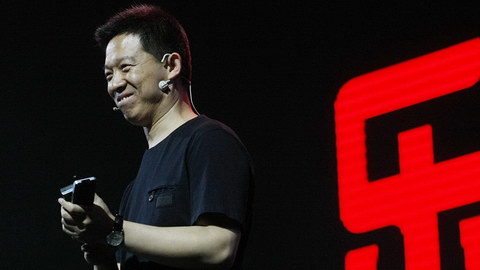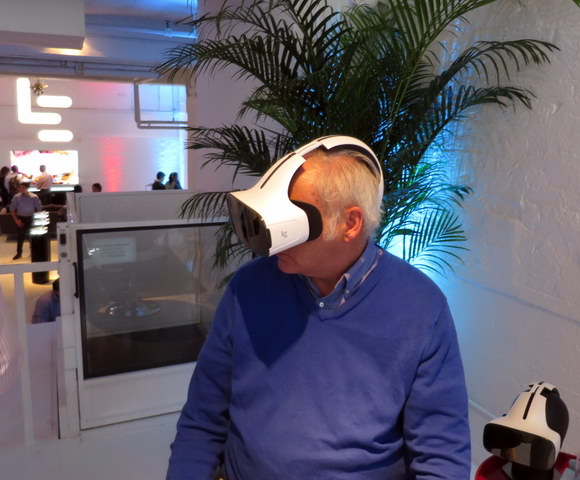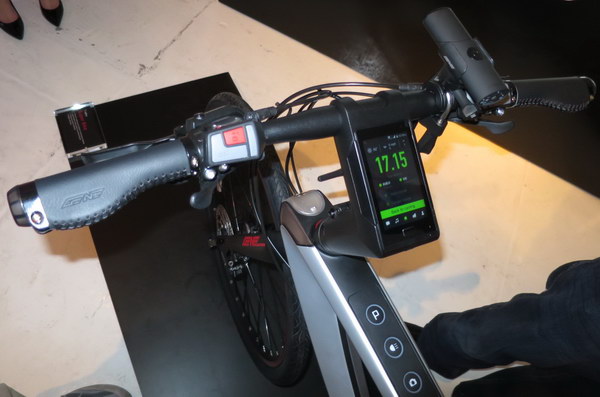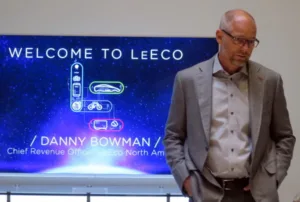I attended an analyst’s luncheon for LeEco (formerly LeTV and before that Le.com) on November 9th in New York. In addition to the analyst’s luncheon, the company had a showcase of their products including their newest, an 85” 4K/UHD HDR Smart TV for $4000.
I was not very familiar with the company before the luncheon but I should have been – Meko has published about 31 articles on LeEco and LeTV since January, 2016. LeEco is making a big push into the United States and CES 2016 was their first appearance there. Part of the push into the US was the $2B acquisition of Vizio announced earlier this year on July 26th.
LeEco’s Danny Bowman at the analysts’ luncheon (Photo: M. Brennesholtz)
Danny Bowman, Chief Revenue Officer, North America was the main speaker at the luncheon. Le.com was founded in 2004 as an app company in China, changed its name early to LeTV and has grown rapidly beyond apps. The name changed again to LeEco in 2015. Currently, according to Bowman, LeEco is the #2 TV company in China and expects to move into the #1 slot in the 2nd half of next year. Hisense is currently #1 in China and is also making a push into the US (subscription required).
According to Bowman, the Vizio name will be retained and the Vizio and LeEco TV brands will remain separate. Vizio will be the low to mid range brand name in the US and LeEco will be the high end brand name. Currently there are four LeEco TVs in the US, Super4 X43Pro, Super4 X55, Super4 X65 and the recently introduced uMax85. Bowman said the LeEco brand TV will be targeting, for example, high-end Samsung TVs. All of the LeEco TVs, even the 43” one, are 4K/UHD SmartTVs. The new 85” TV is a HDR set with 448 dimming zones and both HDR10 and Dolby Vision installed. The TV is said to have 90% of the DCI P3 color gamut used by digital cinema.
Initially, these TVs will be available exclusively through the on-line LeEco store, called LeMall. Bowman said one reason it favored LeMall over other retail channels was the feedback program, UP2U, and the rewards program LeRewards. UP2U is designed to get feedback from the end users to the LeEco product developers so it can be used to improve products across LeEco’s entire ecosystem. In order to get LeRewards, it is necessary to join UP2U. With it’s vertically integrated structure across multiple ecosystems (Bowman said seven), I can see how feedback on phones would help it’s app developers, content creators and streaming service. LeRewards offers a variety of rewards, from a $1000 instant rebate on the uMax85 to discounts from partners and free streaming of some content.
Bowman said the rapid expansion was fueled, in part, but the desire to “verticalize” the company. To Bowman, this meant controlling the hardware, the software, the content and the streaming system. For example, the company not only makes smartphones and apps, but is a content creation company as well. Bowman said that the movie “Legend of Miyue” took in $300M box office in China. He also said the company has the largest video content library in China with 5,000+ movies and 100,000+ TV episodes.
According to Bowman, LeEco is a major player in the music and video streaming business. He said they have 30 terabytes/second capacity worldwide, not just in the US and China. When LeEco streams content, they like to stream LeEco content, including live events such as rock concerts. These live events are actually the core of the LeEco content creation business, not its movies. Bowman said the streaming service had 50M+ daily active users and 730M+ monthly active users.
 Jia Yueting, the billionaire behind LeEco. (Photo: Joel Patel, Autoblog.com)
Jia Yueting, the billionaire behind LeEco. (Photo: Joel Patel, Autoblog.com)
Jia Yueting, the billionaire behind LeEco, is also the man behind Faraday Future, an electric car company that intends to compete with Tesla with an electric vehicle (EV) LeSee. The LeSee is planned to be an autonomous car with its own magnetic charging system and external display. LeEco plans to build a $1.8B factory to build LeSee. LeEco also has a partnership with Aston Martin to build a production version of Aston Martin’s electric RapidE concept car by 2018. Presumably, this car would also be built in the same $1.8B factory as LeSee.
The App background is still clearly visible in the company’s products on display at the showcase. The “Eco” in LeEco is short for “Ecosystem” and one of the company goals it to unite all user experiences under a single user interface called, not surprisingly, Eco User Interface or EUI. The EUI rides on top of the Android operating system used in its products and currently only runs on LeEco products. The goal of the EUI is to provide instant access to all of an end-user’s content, regardless of its original source. It will also give users the same familiar UI on smartphones and TVs. Conventional apps like Netflix, however, will also run on LeEco TVs and smartphones. Presumably, the EUI software will be installed on future Vizio TVs as well.
 Matt Brennesholtz tries the LeEco ExploreVR headset at the product showcase. (Photo: M. Brennesholtz)
Matt Brennesholtz tries the LeEco ExploreVR headset at the product showcase. (Photo: M. Brennesholtz)
The LeEco ExploreVR headset is designed to work with LeEco smart phones and only LeEco phones. It is not just a passive holder of a smartphone with optics to allow the eye to see the image like Google Cardboard and other low-end systems. It includes a built-in proximity sensor and inertial measurement unit, multidirectional touchpad with full control features and connectivity with both Bluetooth and USB Type-C headphones. The price is 300 Yaun (RMB) in China, which is about $55 – $59, but the US price hasn’t been set yet.
The ExploreVR headset was comfortable and looked better than some headsets I’ve tested. The image was fairly good, although like any VR headset based on a smartphone display, the resolution was inadequate and pixels were clearly visible. Latency was less than I’d seen in other smartphone headsets, perhaps due to the high performance Qualcomm Snapdragon 821 processor in the Le Pro3 smartphone used in the headset.
Another product on display was LeEco’s first generation LeBike superbike, currently on sale in China for about $600. This bike features a built in Android-based display and controller that has multiple bells and whistles, including GPS and 4G connectivity. For example, the bike has a built in lock and the fingerprint sensor is used to unlock the bike. According to the LeEco rep telling me about the bike, it was limited to LeEco software – no third party bike apps allowed. The systems are powered by a battery with a 6+ hour life. The battery only powers the electronic systems – this is not an electric bike and you have to pedal it yourself. The company does not plan on selling the first generation bike in the US but is showing it in order to get feedback on the US market for the second generation, which will be sold here.

LeEco’s first generation superbike with integrated controller, currently only on sale in China (Photo: M. Brennesholtz)
Also on display at the showcase were the company’s “Ecophones,” the recently announced high end Le Pro3 and the slightly lower range Le S3. The Le Pro3 will retail for $299 after a $100 instant rebate through the LeRewards program. Initially, it just will be on the company’s on-line store, LeMall, although Bowman said the company intended to establish relationships with the carriers and offer the phones through the carriers in the future. Again, the LeEco brand phones will be at the high end of their product range. In China, the company uses the CoolPad brand for mid- and low-end phones. No mid- or low-end phones have been announced for the US and it is not known if the company will use the CoolPad brand here.
Bowman said that all LeEco products had high-tier hardware at mid-tier prices. This allowed LeEco to upgrade their products in the field just by uploading more advanced apps, software or firmware. While LeEco customers are not locked into LeEco apps or on-line streaming services, presumably these streaming services will provide much of the company’s income in a “razor and razor blade” business model. The company believes the ease of use and convenience of the EUI GUI will encourage end users to use LeEco streaming services to get content.
LeEco also showed a variety of its accessories at the showcase. These included wired and wireless headphones, Bluetooth speakers and battery packs for recharging smartphones.
This extremely rapid expansion of LeEco has led to serious cash-flow problems. Jia Yueting said in a letter to employees in early November, “We blindly sped ahead, and our cash demand ballooned. We got over-extended in our global strategy. At the same time, our capital and resources were in fact limited.” One response to this cash crunch has been for Jia Yueting to take a pay cut to 15¢ (1 Yaun).
When asked about the cash flow problem, Bowman said it will not affect the acquisition of Vizio and that will go ahead as planned. He added that the company plans to manage cash and raise money better in the future. They will also prioritize future developments to better balance growth. One auto industry analyst said the acid test for LeEco will be if they show a fully functional, production ready EV at CES 2017. With it’s planned expansion into the US, it’s hard to imagine even a cash flow problem would keep LeEco from LeCES 2017. –Matthew Brennesholtz

